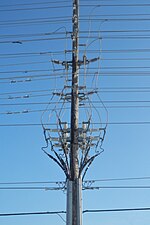Power networks/Canada/Ontario
This page is dedicated for the mapping of power-related infrastructure in Ontario.
Background
The Ontario power grid uses transmission voltages also used in nearby provinces (except Quebec) and U.S. states. Distribution lines are usually 8.0/13.8 and 14.4/25 kV, but 2.4/4.16 kV systems remains in large cities like Toronto and Ottawa.
The Ontario grid is mostly operated by Hydro One; distribution is operated by various regional and local hydro companies in addition to Hydro One. The grid connects with the U.S. grid, Manitoba Hydro's Manitoba grid and Hydro-Québec's Quebec grid.
In Ontario, electric power is often spoken of as "hydro", regardless of source. Power lines are referred to as "hydro lines", transmission towers as "hydro towers", power poles as "hydro poles" and transmission corridors (e.g. those in Greater Toronto) as "hydro corridors".
All existing power lines in Ontario presently mapped can be seen in Open Infrastructure Map
Voltages
Operators
For transmission lines and facilities in Ontario, Hydro One can be assumed unless marked otherwise. For distribution lines and facilities, refer to the list below, which also provides service areas (this can include surrounding rural areas, not just the city or town limits), otherwise use also Hydro One (which does provide distribution elsewhere in the province).
- Alectra (Aurora, Alliston, Barrie, Beeton, Bradford West Gwillimbury, Brampton, Guelph, Hamilton, Markham, Mississauga, Penetanguishene, Richmond Hill, Rockwood, St. Catharines, Thornton, Tottenham, Vaughan)
- Algoma Power (Algoma)
- Canadian Niagara Electric (Fort Erie, Port Colborne)
- Cornwall Electric (Cornwall, South Glengarry, South Stormont, Akwesasne)
- Elexicon Energy (Ajax, Pickering, Whitby, Belleville, Bowmanville, Gravenhurst, Uxbridge, Scugog)
- Energy+ (Cambridge, North Dumfries, Brantford)
- Enova Power (Kitchener, Waterloo, Woolwich, Wilmot, Wellesley)
- EPCOR (Collingwood, Stayner, Creemore, Thornbury)
- Festival Hydro (Stratford, St. Mary's, Seaforth, Hensall, Brussels, Zurich, Dashwood)
- Greater Sudbury Hydro (Sudbury, West Nipissing)
- Hydro Ottawa (Ottawa, Casselman)
- London Hydro (London)
- Oakville Hydro (Oakville)
- Synergy Power (Kenora, Thunder Bay)
- Toronto Hydro (Toronto)




